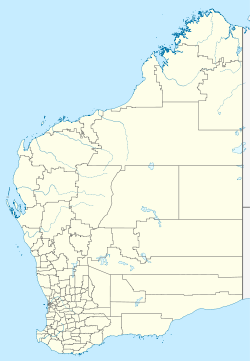- Collier Range National Park
-
Collier Range National Park Location Pilbara, Western Australia Nearest city Newman Coordinates 24°37′25″S 119°16′19″E / 24.62361°S 119.27194°ECoordinates: 24°37′25″S 119°16′19″E / 24.62361°S 119.27194°E Area 235,162 hectares (581,098 acres)[1] Established 1978 Governing body Department of Environment and Conservation Collier Range National Park is a national park in the Pilbara region of Western Australia, 878 km (546 mi) northeast of Perth.
The nearest major town to the park is Newman located about 166 km (103 mi) north near Kumarina.[2] The park is one of many in the Pilbara and was established in 1978. [3]
The ranges vary from low hills to high ridges with many cliffs. The vegetation found in the area is mostly spinifex and mulga with creeklines being surrounded by eucalypts. Mulga scrub and mulla mulla are found in dense scrubland in the northeastern plains with spinifex and sand dunes being found in the western end.[4]
The park is the home of the rare Pilbara Pebble-Mound Mouse Pseudomys chapmani which is also found in the Millstream-Chichester National Park and the Karlamilyi National Park.[5]
The mulgara habitat is a refuge for the critical weight range mammals such as Macrotis lagotis, Dasycercus crassicaudata and Dasyurids.
The standard of management in the park is poor and is only visited occasionally by Department of Environment and Conservation staff from Karratha. The park is baited for wild dogs but suffers damage from feral donkeys and wandering cattle. No fire management is in practice and weed probems are unknown.[6]
See also
References
- ^ Department of Environment and Conservation 2009–2010 Annual Report. Department of Environment and Conservation. 2010. pp. 48. ISSN 1835-114X. http://www.dec.wa.gov.au/content/view/6139/2345/.
- ^ "RAC Travel- National Park Camping Areas". 2008. http://rac.com.au/Travel/Self-drive-holidays/Caravans-and-camping/National-park-camping-areas.aspx. Retrieved 2010-05-04.
- ^ "Rundle Range National Park". 2002. http://pheeds.com/Rundle_Range_National_Park.html. Retrieved 2010-05-04.
- ^ "Cape Range Area (entry AHD10830)". Australian Heritage Database. Department of Sustainability, Environment, Water, Population and Communities. 2010. http://www.environment.gov.au/cgi-bin/ahdb/search.pl?mode=place_detail;place_id=10830. Retrieved 2010-11-26.
- ^ "Department of Environment - Action Plan for Australian Rodents". 1995. http://www.environment.gov.au/biodiversity/threatened/publications/action/rodents/rodap5.html. Retrieved 2010-05-04.
- ^ "Gascoyne Subregion Biodiversity values". 2001. http://www.dec.wa.gov.au/pdf/science/bio_audit/gascoyne03_p240-251.pdf. Retrieved 2010-09-28.
National parks of Western Australia Alexander Morrison · Avon Valley · Badgingarra · Beedelup · Beelu · Boorabbin · Brockman · Cape Arid · Cape Le Grand · Cape Range · Collier Range · D’Entrecasteaux · Drovers Cave · Drysdale River · Eucla · Fitzgerald River · Francois Peron · Frank Hann · Geikie Gorge · Gloucester · Goongarrie · Gooseberry Hill · Greenmount · Gull Rock · Hassell · Hidden Valley · John Forrest · Kalamunda · Kalbarri · Karijini · Karlamilyi · Kennedy Range · Leeuwin-Naturaliste · Lesmurdie Falls · Lesueur · Millstream-Chichester · Mirima · Mitchell River · Moore River · Mount Augustus · Mount Frankland · Nambung · Neerabup · Peak Charles · Porongurup · Purnululu · Rudall River · Scott · Serpentine · Shannon · Sir James Mitchell · Stirling Range · Stokes · Tathra · Torndirrup · Tuart Forest · Tunnel Creek · Walpole-Nornalup · Walyunga · Warren · Watheroo · Waychinicup · West Cape Howe · William Bay · Windjana Gorge · Wolfe Creek Meteorite Crater · Yalgorup · YanchepCategories:- IUCN Category II
- National parks of Western Australia
- Protected areas established in 1978
- Western Australia geography stubs
Wikimedia Foundation. 2010.

